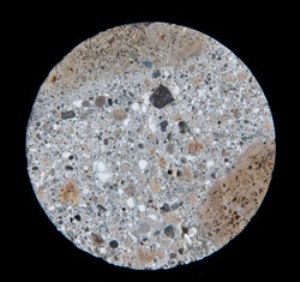Jun 5 2013
In a quest to make concrete more durable and sustainable, an international team of geologists and engineers has found inspiration in the ancient Romans, whose massive concrete structures have withstood the elements for more than 2,000 years.
 Sample of ancient Roman maritime concrete from Pozzuoli Bay near Naples, Italy. Its diameter is 9 centimeters, and it is composed of mortar formulated from lime, volcanic ash and chunks of volcanic tuff. (Carol Hagen photo)
Sample of ancient Roman maritime concrete from Pozzuoli Bay near Naples, Italy. Its diameter is 9 centimeters, and it is composed of mortar formulated from lime, volcanic ash and chunks of volcanic tuff. (Carol Hagen photo)
Using the Advanced Light Source at Lawrence Berkeley National Laboratory (Berkeley Lab), a research team from the University of California, Berkeley, examined the fine-scale structure of Roman concrete. It described for the first time how the extraordinarily stable compound – calcium-aluminum-silicate-hydrate (C-A-S-H) – binds the material used to build some of the most enduring structures in Western civilization.
The discovery could help improve the durability of modern concrete, which within 50 years often shows signs of degradation, particularly in ocean environments.
The manufacturing of Roman concrete also leaves a smaller carbon footprint than does its modern counterpart. The process for creating Portland cement, a key ingredient in modern concrete, requires fossil fuels to burn calcium carbonate (limestone) and clays at about 1,450 degrees Celsius (2,642 degrees Fahrenheit). Seven percent of global carbon dioxide emissions every year comes from this activity. The production of lime for Roman concrete, however, is much cleaner, requiring temperatures that are two-thirds of that required for making Portland cement.
The researchers’ findings are published in two papers, one that appears online today (Tuesday, June 4) in the Journal of the American Ceramic Society, and the other scheduled to appear in the October issue of the journal American Mineralogist.
“Roman concrete has remained coherent and well-consolidated for 2,000 years in aggressive maritime environments,” said Marie Jackson, lead author of both papers. “It is one of the most durable construction materials on the planet, and that was no accident. Shipping was the lifeline of political, economic and military stability for the Roman Empire, so constructing harbors that would last was critical.”
The research team was led by Paulo Monteiro, a UC Berkeley professor of civil and environmental engineering and a faculty scientist at Berkeley Lab, and Jackson, a UC Berkeley research engineer in civil and environmental engineering. They characterized samples of Roman concrete taken from a breakwater in Pozzuoli Bay, near Naples, Italy.
Building the Empire
Concrete was the Roman Empire’s construction material of choice. It was used in monuments such as the Pantheon in Rome as well as in wharves, breakwaters and other harbor structures. Of particular interest to the research team was how Roman’s underwater concrete endured the unforgiving saltwater environment.
The recipe for Roman concrete was described around 30 B.C. by Marcus Vitruvius Pollio, an engineer for Octavian, who became Emperor Augustus. The not-so-secret ingredient is volcanic ash, which Romans combined with lime to form mortar. They packed this mortar and rock chunks into wooden molds immersed in seawater. Rather than battle the marine elements, Romans harnessed saltwater and made it an integral part of the concrete.
The researchers also described a very rare hydrothermal mineral called aluminum tobermorite (Al-tobermorite) that formed in the concrete. “Our study provided the first experimental determination of the mechanical properties of the mineral,” said Jackson.
So why did the use of Roman concrete decrease? “As the Roman Empire declined, and shipping declined, the need for the seawater concrete declined,” said Jackson. “You could also argue that the original structures were built so well that, once they were in place, they didn’t need to be replaced.”
An earth-friendly alternative
While Roman concrete is durable, Monteiro said it is unlikely to replace modern concrete because it is not ideal for construction where faster hardening is needed.
But the researchers are now finding ways to apply their discoveries about Roman concrete to the development of more earth-friendly and durable modern concrete. They are investigating whether volcanic ash would be a good, large-volume substitute in countries without easy access to fly ash, an industrial waste product from the burning of coal that is commonly used to produce modern, green concrete.
“There is not enough fly ash in this world to replace half of the Portland cement being used,” said Monteiro. “Many countries don’t have fly ash, so the idea is to find alternative, local materials that will work, including the kind of volcanic ash that Romans used. Using these alternatives could replace 40 percent of the world’s demand for Portland cement.”
The research began with initial funding from King Abdullah University of Science and Technology in Saudi Arabia (KAUST), which launched a research partnership with UC Berkeley in 2008. Monteiro noted that Saudi Arabia has “mountains of volcanic ash” that could potentially be used in concrete.
In addition to KAUST, funding from the Loeb Classical Library Foundation, Harvard University and the Department of Energy’s Office of Science helped support this research. Samples were provided by Marie Jackson and the Roman Maritime Concrete Study (ROMACONS), sponsored by CTG Italcementi, a research center based in Bergamo, Italy. The researchers also used the Berlin Electron Storage Ring Society for Synchrotron Radiation, or BESSY, for their analyses.